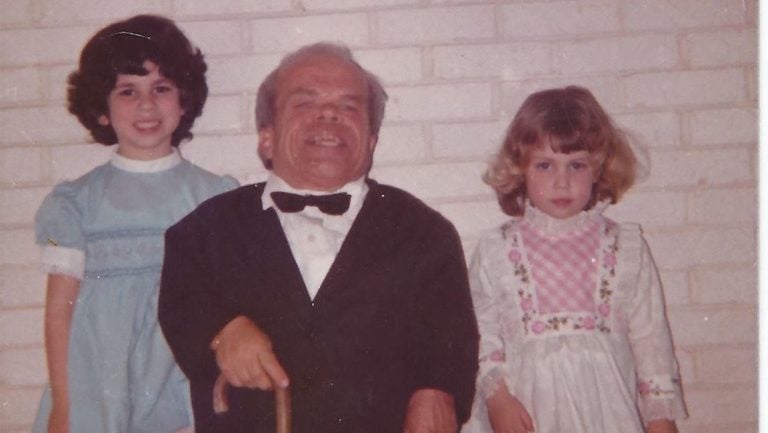Lessons from my Great-Uncle Mace on photobombing, having fun and being different

(L to R) The author's sister
When I was a child, these are some of the things that I loved to do when I visited my Great-Uncle Mace:
Lay next to him on the floor while he spread out the paper to read the news, while I read the comics
Go for rides with him and my siblings in his open-air Jeep to get ice cream
Play Goldilocks and the Three Bears with my big sister in his apartment, where all of the furniture and appliances were built to his height — and consequently, to ours.
My Great-Uncle Mace was an achondroplastic dwarf — 43 inches tall. He had a hump on his back and walked with a cane. Of all the relatives we grew up visiting with, Mace stood out as a clear favorite: not only did he literally see eye-to-eye with us in our younger years, but he talked to us children like we were equals.
Mace died when I was 11, but spending time with him in my formative years made a great impression on me. Mace had a way of making everything more fun. I remember him talking back to the TV, calling out Yiddish expletives while we were watching our favorite police shows. He’d interview us on his cassette player and attached microphone as if we were celebrities on a talk show who had important things to say.
I never thought that much about his size or considered the adversity that he had overcome because of people’s prejudices towards dwarfs. I was not conscious of the choice that he made to be a positive person despite being regularly taunted about his size while growing up. Mace built a successful business from nothing, worked tirelessly for charities and relentlessly pursued his hobby of taking photos with celebrities. Mace’s spirit and energy were larger than life — and that is what the people who knew him remember most.
Over the past few years, I’ve had the awesome opportunity of getting to understand Mace’s life in greater depth while researching my memoir about his extraordinary life, “The Little Gate Crasher”. Hearing stories about Mace from people who knew him has allowed me to appreciate Mace’s accomplishments from an adult perspective.
While I was writing the book and would share about it with friends and acquaintances, I was shocked to discover that many people have a prejudice towards people who are dwarfs. When I would start describing my book, someone might say, “Dwarfs freak me out” or “Dwarfs scare me.” I was, at first, taken aback; there was no awareness that their responses were dehumanizing to an entire group of people.
In my research, I uncovered not only the personal challenges that Mace faced, but also the more global prejudice that dwarfs have both historically and currently face. And in addition to attitudinal prejudice, dwarfs face the accessibility challenges that come with living in a world that doesn’t have restrooms and other human necessities built to their size.
I realized what a gift it was that my siblings and I got to know our amazing Great-Uncle and to understand him not as a dwarf, but as a remarkable human being. As parents, we need to make sure that we are educating our children about understanding the wide arrays of differences in human beings.
Achondroplasiac dwarfs account for one per 26,000 to 40,000 births — so most of us don’t know someone personally who is a dwarf. As children, most of us first associate little people with “Snow White” — where the dwarfs are set apart, as their own species — and we don’t gain any sense that dwarfs could be real people we know in our communities.
There are many ways that we parents can talk to our children about people who look different because of their size, so that when they see or meet a dwarf in real life, they won’t have anything to fear.
Talk about dwarfs in media: After “Snow White,” your kids will likely see actors who are dwarfs in “The Wizard of Oz” or “Willy Wonka and the Chocolate Factory.” Take a moment to talk about the actors they see on the screen…what would it feel like if you were a little person and the only roles you could play were as a munchkin or Oompa-Loompa?
Watch together: TLC has done a great job in giving us a window into what it’s like to simply be a human being who happens to a dwarf. Watch an episode of “The Little Couple” with your kids and invite them to share their reactions.
Smile: It is natural for human beings to stare when we see something that is different. For me, as a mom of a son with developmental disabilities, I am often in the position of being stared at when I’m walking with my son who is taller than me and people notice me holding his hand to guide him safely while we are walking. Dwarfs are stared at all of the time. Make a conscious effort to turn your stare into a smile when you do see someone who is different. Talk to your children about how it feels to be stared at and why this is rude behavior.
Be sure to check out lots of fun pictures of my Great-Uncle Mace through his life — come take a look!
WHYY is your source for fact-based, in-depth journalism and information. As a nonprofit organization, we rely on financial support from readers like you. Please give today.

